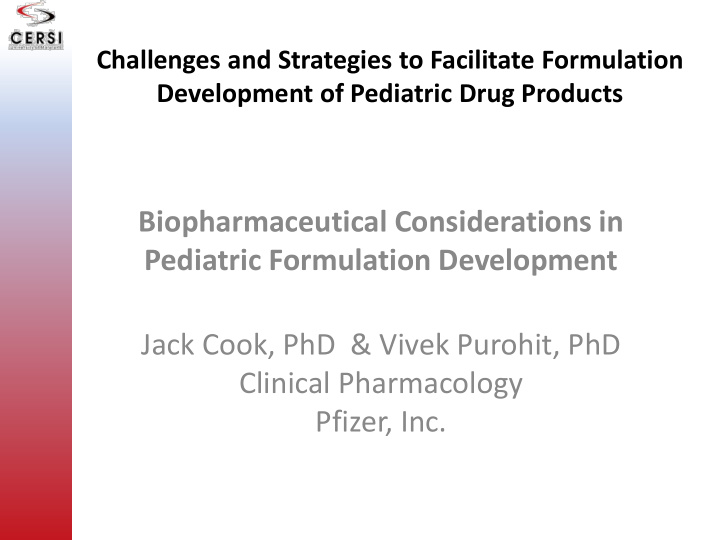



Challenges and Strategies to Facilitate Formulation Development of Pediatric Drug Products Biopharmaceutical Considerations in Pediatric Formulation Development Jack Cook, PhD & Vivek Purohit, PhD Clinical Pharmacology Pfizer, Inc.
Questions for Pediatric Drug Development • How can we use the BCS system to quantify the biopharmaceutic risk during pediatric drug development? • Can we use data collected during the conduct of pediatric studies to confirm what we know about the biopharmaceutic performance of the drug in adults? • When should we reconsider the BCS classification of a drug for pediatrics?
Typically - 2 Objectives • Initial: Predicting doses in order to develop a pediatric formulation that results in similar exposures in pediatric patients as the adult formulation does in adult patients – FDA survey found that Extrapolation of efficacy from adult data occurred for 82.5% of the drug products ( Dunne,W.J. Rodriguez,M.D.Murphy, B.N. Beasley,G.J. Burckart, J.D. Filie, L.L. Lewis, H.C. Sachs, P.H. Sheridan, P. Starke, L.P. Yao, Extrapolation of adult data and other data in pediatric drug-development programs, Pediatrics 128 (2011) e1242–e1249.) • Subsequent: Demonstrate bioequivalence of pediatric formulations to a reference
Initial – Predicting Dose Good News • Adult exposure typically predictive of efficacy Predict adolescent doses well, • other groups typically adequately • Predicted CL= Adult CL * (adolescent wt/70kg) 0.75 Challenges Dose range over typical • weights from 0 to 18 yrs is Lily Mulugeta, Pharm.D, Adolescent PK Studies Under about 10 fold (given a single PREA and BPCA. FDA Advisory Committee for dose level for adults) Pharmaceutical Science and Clinical Pharmacology Meeting March 14, 2012, National Harbor, MD
Market Image Vs Enabling Formulations. Market Image or Commercial Enabling Formulation Formulation • Pros • Pros – Minimal upfront development – No Biopharmaceutic risk cost – No bridging BA/BE studies – Commercial age appropriate formulation development can needed be staged • Cons – Shorter lead time – Requires large lead time and • Cons significant advance planning – More biopharmaceutic risk – Upfront cost for product – Will need eventual BA/BE study development for the commercial formulation.
Decision Tree for Pediatric Formulation Choice Strategy Though dose will likely need encompass ½ the adult dose
What next? • Market image/commercial formulation used during pediatric development – straight forward. • Enabling formulation used during pediatric development – will require bridging using clinical study or biowaiver argument based on BCS.
Scientific Necessity in Children • Children should only be enrolled in a clinical trial if necessary to answer an important scientific question: – Determine the type and timing of clinical studies required for establishing "safe and effective" pediatric use of drugs, biologics and devices • Children should only be enrolled if essential (i.e., no other option, whether animal or adult human) Minimize Risks and Equitable Selection [US 21 CFR 56.111(a)(1) and (b)] 40 Adapted from Office of Pediatric Therapeutics (Michelle Roth-Cline, MD)
Clinical Bridging Studies for Pediatric Formulations • Usually done in adult healthy volunteers • BE in pediatric is implied: if it is BE in adults it will be BE in peds. • Question often asked: Is demonstration of BE in adults applicable to pediatric populations? • Concrete data difficult to find. • BA/BE studies in pediatric populations are not feasible from an ethical perspective. • Estimation of bioavailability or relative bioavailability possible in pediatrics if PK data on formulations of interest is collected. AAPS, 2011, Poster # R6349
What About Biowaiver: Is BCS Appropriate for Pediatrics? • Peds Vs Adults differ in: dose, volume of liquid consumed, gi physiology, transit times, permeability etc. • Hence, the same BCS assumptions (critical values) may not apply for pediatrics. Great area for more research • BCS 1 and 3 drugs which are eligible for biowaiver are likely most impacted.
Summary • Biopharmaceutical characteristics can help one decide whether to start with the market image or an enabling formulation • If there are questions regarding the applicability of extrapolating BCS or adult BE to a pediatric population, it may always be better to take the time to develop the market image.
Recommend
More recommend